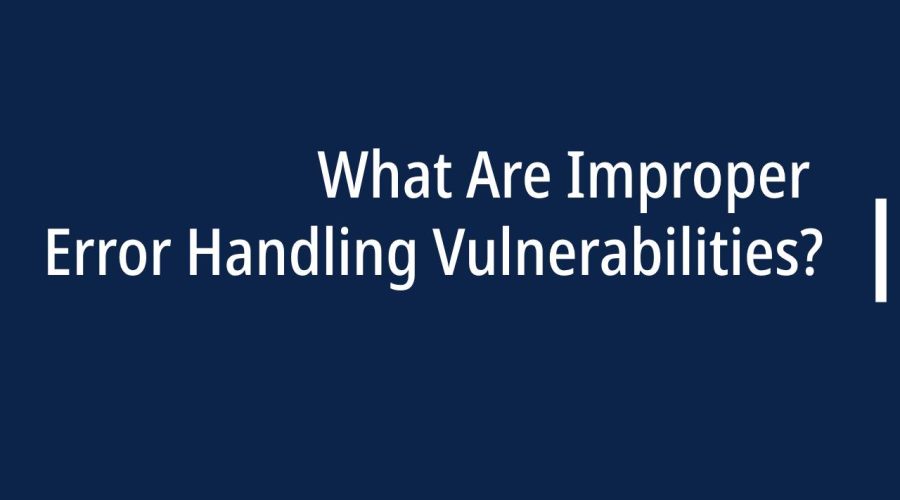Software developers and security professionals face the daunting challenge of protecting systems and applications from a myriad of threats. One often-overlooked aspect of cybersecurity is improper error handling vulnerabilities. In this comprehensive guide, we’ll dive into what improper error handling vulnerabilities are, the risks they pose, and effective solutions to mitigate these risks.
Understanding Improper Error Handling Vulnerabilities
Improper error handling vulnerabilities refer to situations where software or web applications fail to handle errors, exceptions, or unexpected events appropriately. These vulnerabilities can manifest in various ways, including:
- Stack Traces: When an application crashes, it might display detailed error messages or stack traces to the user. This information can be valuable to attackers.
- Sensitive Data Exposure: Inadequate error handling might reveal sensitive data like database connection strings, API keys, or personally identifiable information (PII) to potential attackers.
- Denial of Service (DoS): Attackers can exploit improper error handling to launch DoS attacks, overwhelming an application with errors and causing it to become unresponsive.
- Information Leakage: Incomplete error handling can lead to the disclosure of information about the system’s architecture or its vulnerabilities, aiding attackers.
Risks of Improper Error Handling Vulnerabilities
Improper error handling vulnerabilities can have severe consequences for both users and organizations. Let’s delve into the risks associated with these vulnerabilities:
- Data Breaches: If sensitive information is exposed due to improper error handling, it can lead to data breaches and regulatory fines.
- Application Crashes: Inadequate error handling may lead to application crashes, causing disruptions and frustrating users.
- Loss of Reputation: Repeated application crashes and data leaks can tarnish a company’s reputation, resulting in a loss of customer trust.
- Legal Consequences: Non-compliance with data protection regulations, like GDPR, can lead to severe legal consequences.
- Security Vulnerabilities: Attackers can exploit error messages and stack traces to identify weaknesses in an application’s security.
Examples of Improper Error Handling Vulnerabilities
To better understand the impact of improper error handling vulnerabilities, here are some real-world examples:
- Exposed API Keys: Insecure error handling can lead to API keys being revealed, allowing unauthorized access to sensitive data or services.
- Stack Traces in Web Applications: Displaying detailed stack traces in web applications can provide attackers with valuable insights into the application’s structure and potential vulnerabilities.
- SQL Injection Errors: When SQL injection errors aren’t handled correctly, they can reveal database structure and potentially lead to unauthorized data access.
- Brute-Force Attacks: An application that doesn’t adequately handle authentication errors may be susceptible to brute-force attacks, compromising user accounts.
Solutions to Mitigate Improper Error Handling Vulnerabilities
Addressing improper error handling vulnerabilities is crucial for enhancing software security. Here are effective solutions to mitigate these vulnerabilities:
- Custom Error Messages: Implement custom error messages that do not reveal sensitive information. Generic error messages like “An error occurred” can help prevent data exposure.
- Logging and Monitoring: Implement comprehensive logging and monitoring to track errors, providing insights into system behavior and potential vulnerabilities.
- Rate Limiting: Implement rate limiting to protect against DoS attacks by restricting the number of requests from a single source in a specified time frame.
- Thorough Code Reviews: Conduct regular code reviews to identify and fix improper error handling issues.
- OWASP Guidelines: Follow the guidelines provided by the Open Web Application Security Project (OWASP) for secure error handling in web applications.
- Use Exception Handling: Utilize appropriate exception handling techniques in your code to gracefully handle errors.
- Regular Security Testing: Perform penetration testing and security assessments to identify and fix error handling vulnerabilities.
Best Practices for Secure Error Handling
To ensure your applications are resilient to improper error handling vulnerabilities, consider the following best practices:
- Implement a Robust Error Handling Strategy: Design a comprehensive error handling strategy that covers all potential errors and exceptions.
- Test for Error Scenarios: Test your applications for various error scenarios to ensure that error handling mechanisms work as intended.
- Secure Error Messages: Always sanitize and secure error messages to prevent data leakage.
- User-Friendly Errors: Provide user-friendly error messages that do not expose technical details.
- Regular Updates: Keep your software and libraries up to date to benefit from security patches and fixes.
- Educate Developers: Ensure your development team is well-versed in secure coding practices and error handling.

Gloria Bradford is a renowned expert in the field of encryption, widely recognized for her pioneering work in safeguarding digital information and communication. With a career spanning over two decades, she has played a pivotal role in shaping the landscape of cybersecurity and data protection.
Throughout her illustrious career, Gloria has occupied key roles in both private industry and government agencies. Her expertise has been instrumental in developing state-of-the-art encryption and code signing technologies that have fortified digital fortresses against the relentless tide of cyber threats.
